Kendal WwTW (2019)
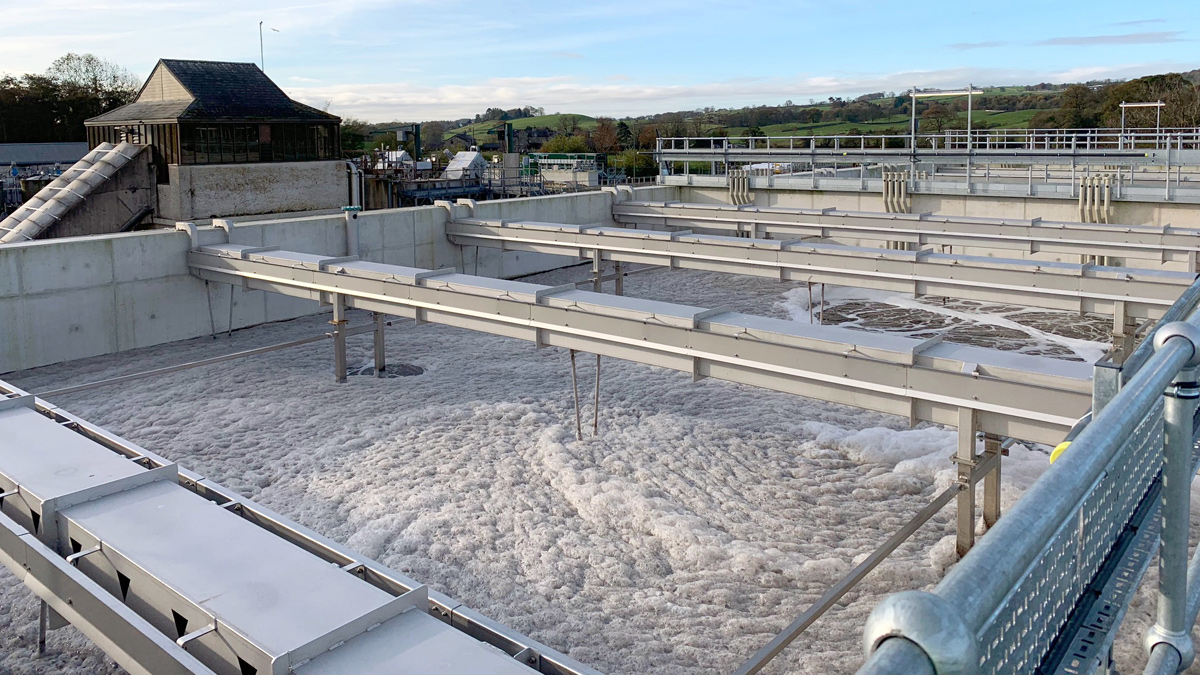
Nereda® in aeration, Kendal WwTW - Courtesy of United Utilities
Kendal WwTW is the main treatment facility for the area servicing a large residential and tourist catchment, with a population equivalent of 82,384. The works has an existing consent of 25 mg/l biological oxygen demand (BOD) 45mg/l suspended solids, 5 mg/l ammonia, and an annual average phosphorus permit of 1 mg/l, with a flow to full treatment (FTFT) of 41,990m3/d. The final effluent from Kendal WwTW discharges into the River Kent. The River Kent ultimately becomes the Kent Estuary and then part of Morecambe Bay. The £18m investment by United Utilities will deliver a significant improvement to the Cumbrian Kendal Catchment.
Project needs
Due to forecasted population growth, Kendal WwTW attracted an AMP6 No Deterioration driver, confirmed in the Environment Agency, National Environment Programme (NEP) 5 in January 2016. This was also included in the OFWAT PR14 submission, and was characterised by a tightened permitted ammonia discharge standard from the current 8 mg/l to 5 mg/l (95th percentile spot sample basis).
The project had a regulatory commitment date of 20 March 2019 and on completion and acceptance of the revised permit, United Utilities would be able claim 20.21Km towards the Rivers Improved AMP6 performance commitment.
Background
In 2013 an engineering team from United Utilities visited Royal HaskoningDHV in Holland, they were able to experience the Nereda® technology first hand. Returning from that visit the team advised the business to pursue the technology and a trial would be required in order to answer a series of technical and commercial considerations. The first trial was carried out at Davyhulme WwTW from 2014 and later moved to Crewe WwTW in Cheshire.
Through the collaborative partnership between United Utilities and Royal HaskoningDHV the trials proved extremely successful and subsequently Kendal WwTW was identified as the first site to implement this new innovative technology.
The preferred solution was chosen for constructability, due to the compact size of the site, whole life cost and potential future opportunities such as resource recovery. Nereda® offered an opportunity to provide a solution without the need to construct primary or secondary settlement tanks, which would otherwise be required for a more conventional activated sludge solution.
The technology also offered lower whole life cost, high effluent quality including biological phosphorus removal, and potential for product recovery. Many other benefits including alignment to United Utilities Systems thinking strategy achieved through self-optimisation, and through the use of the AquaSuite Nereda® Controller and alignment with systems thinking.
The main contract was awarded to LiMA, a Laing O’Rourke/Atkins joint venture, who worked collaboratively with United Utilities to develop the outline design before the contract was signed for the formal delivery stage.
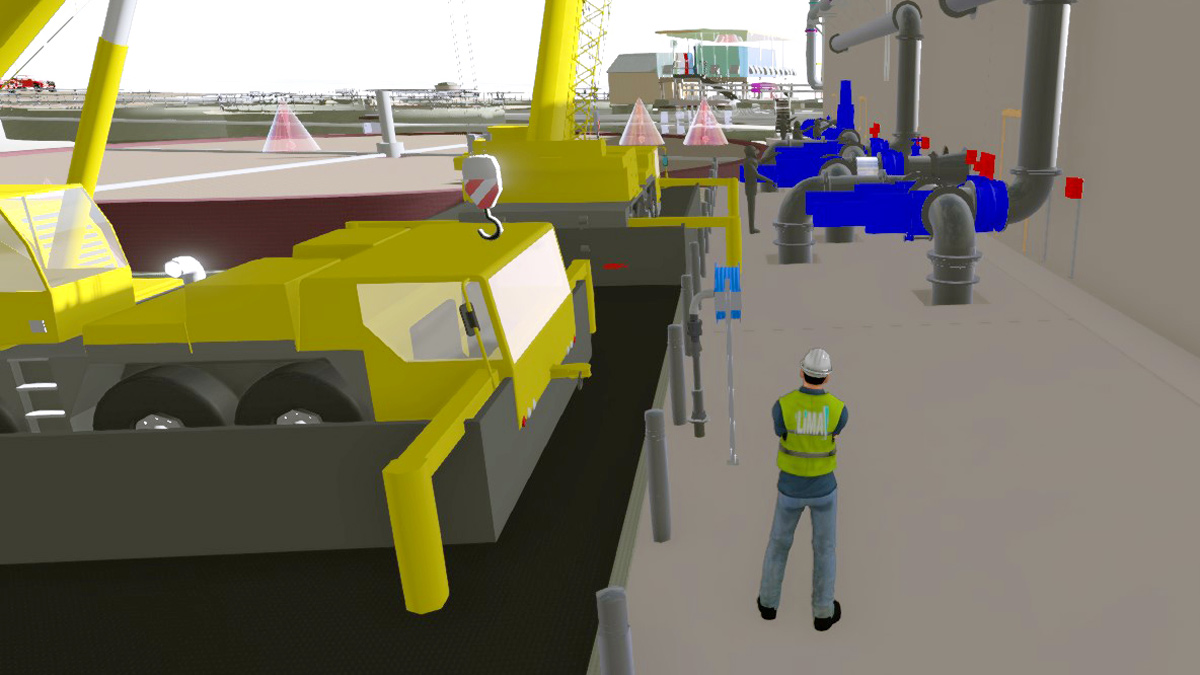
Virtual reality 3D model – Courtesy of United Utilities
Design
A solution had to be created which incorporated the integration of existing assets and the following opportunities and constraints considered:
- The opportunity to reuse of inlet works including inlet screens, detritors and pumping station.
- The limited footprint on site for implementing a solution.
- The risk of having to build, test and commission live on site whilst integrating new assets.
- The challenge of phasing the commissioning sequence whilst the site was online.
Challenges included integrating the chosen solution with the dated sewage works at the site, which was originally constructed in the early 1900s. There was significant damage to the site as a result of Storm Desmond in 2015, which took many months to recover. Therefore as part of the design and build for this project, future resilience was embedded into the design, including elevating key assets such as MCC kiosks.
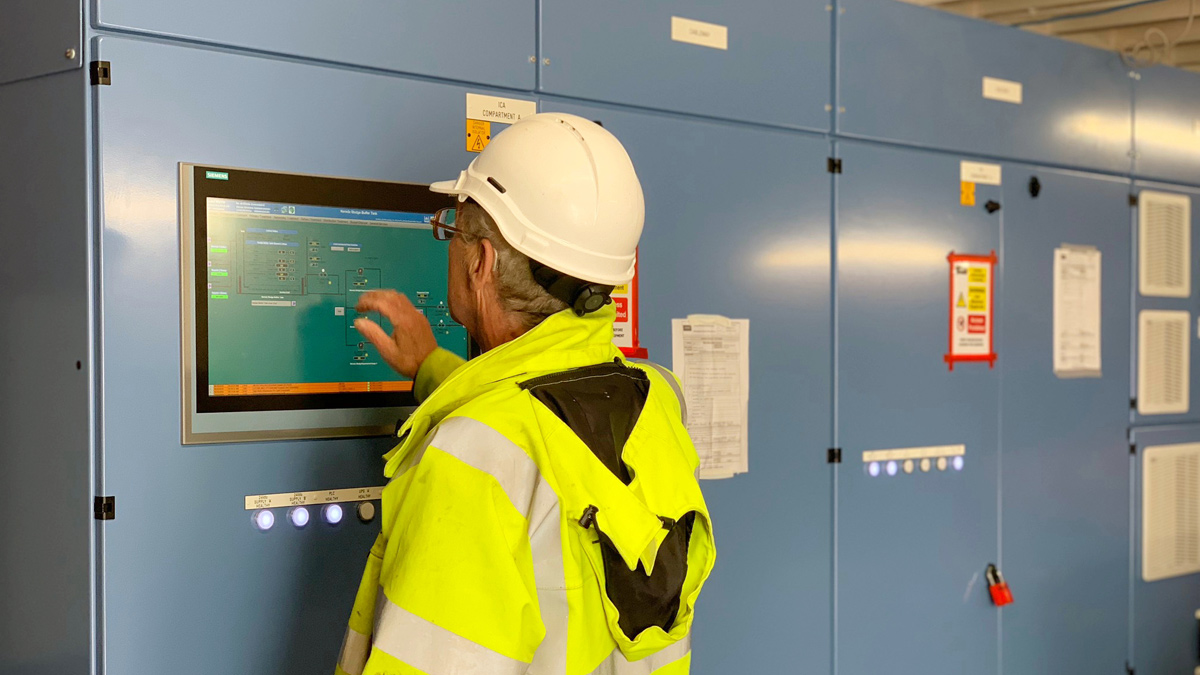
New MCC and HMI panel – Courtesy of United Utilities
Construction elements
The construction solution involved the following main elements:
- New Nereda® treatment process comprising 3 (No.) reactors, total volume 11,000m3.
- New Nereda® feed pumping station.
- New sludge buffer tank.
- Conversion of an existing clarifier tank to the Nereda® feed buffer tank.
- New sludge thickening process.
- Associated MCCs and SCADA works.
- Refurbishment of the existing inlet works.
The implementation of the Nereda® solution at Kendal WwTW will remove the need to operate the existing COAST (high rate (ASP) activated sludge plant (ASP) with direct oxygen injection), trickling filters, and two stages of settlement. The site footprint is significantly constrained on three sides by the River Kent which presented a significant challenge for the project. Prior to the main construction commencing, an area of the site had to be cleared to make way for the new Nereda® plant. Due to the reduction in footprint required, this allowed for just four of the existing eleven filters to be demolished, which meant the site team could maintain compliance throughout construction and was a significant decision factor in the optioneering process.
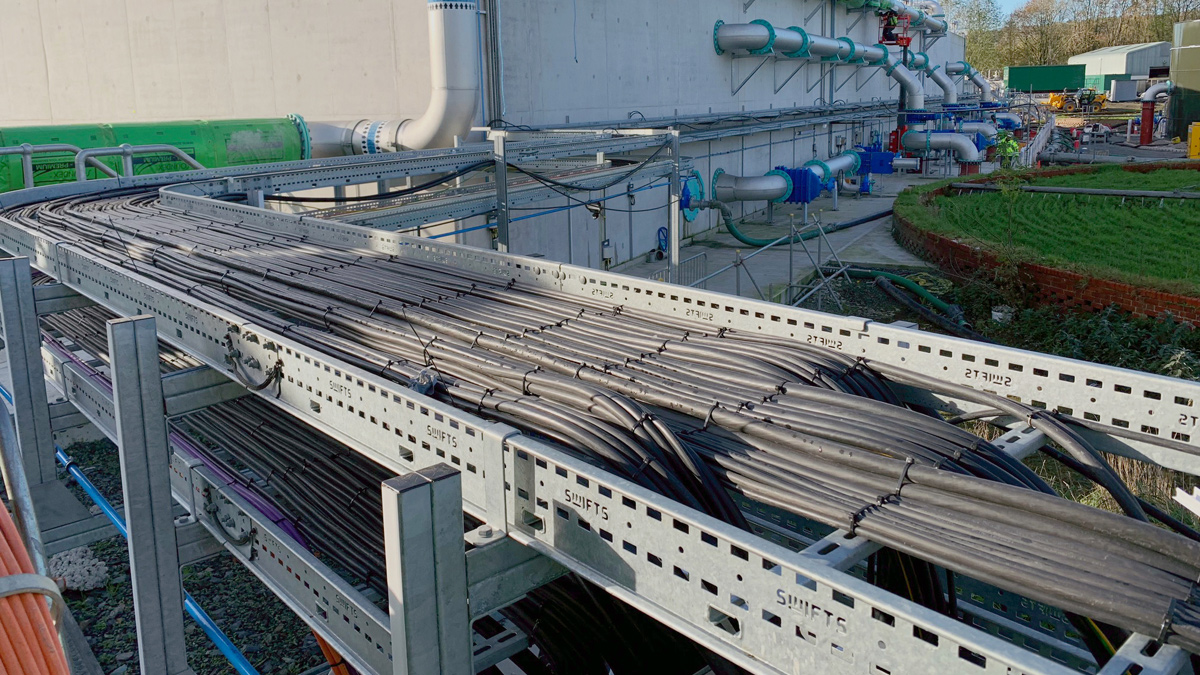
Cable ducting Kendal WwTW – Courtesy of United Utilities
The Nereda® process
The Nereda® granular activated sludge process is a highly compact approach for the treatment of wastewater compared to conventional activated sludge as it does not require final settlement tanks. It was established that primary settlement could also be omitted, whilst also enabling existing assets to be converted. Such as clarifier four on site being converted to a buffer feed tank, to enable higher quality effluent to be discharged.
The Nereda® process involves a sequenced batch reactor consisting of three operations, each containing phases. The first stage is the feed stage, this involves de-gritted sewage being fed into the reactor through a distribution grid, located at the bottom of the reactor. The up flow enables final effluent to discharge from the top of the process units, with a feed and draw process. The feed operation is under anaerobic conditions, which help promote the formation of granules.
The second stage is aeration, this involves air being supplied to the reactor, which encourages mixing and removal of pollutants. Finally the settle operation, where granules are left to settle leaving the sludge blanket, for the subsequent feed to pass through. Surplus sludge is removed at the end of feed operation.
The revolutionary Nereda® technology process prefers a highly loaded environment. In granular biomass three process zones are present in different layers inside the granular particles, with diffusion connecting the reactions zones, thus allowing simultaneous anaerobic, aerobic and anoxic conditions to co-exist in the granules resulting in biological nutrient removal capabilities. The dense granules settle up to five times faster than a conventional process.
As the Nereda® technology typically removes biological phosphorus to less than 1 mg/l, reducing the amount of chemical coagulant required, therefore reducing operational costs. In the future there is potential scope for phosphorus to be extracted from the granules, which could be used to trade as a commodity in the future.
Kendal WwTW: Key participants
- Design & project delivery: LiMA – Laing O’Rourke/Atkins JV
- Geotechnical investigation: Geotechnics Ltd
- Nereda® process technology: Royal HaskoningDHV
- Electrical engineering: Bilfinger
- Mechanical installation: Suprafilt Ltd
- Systems integration/software: Tata Consultancy Services
- MCC: Lloyd Morris Electrical Ltd
- Pumps: Sulzer Pumps
- Blowers: Aerzen Machines
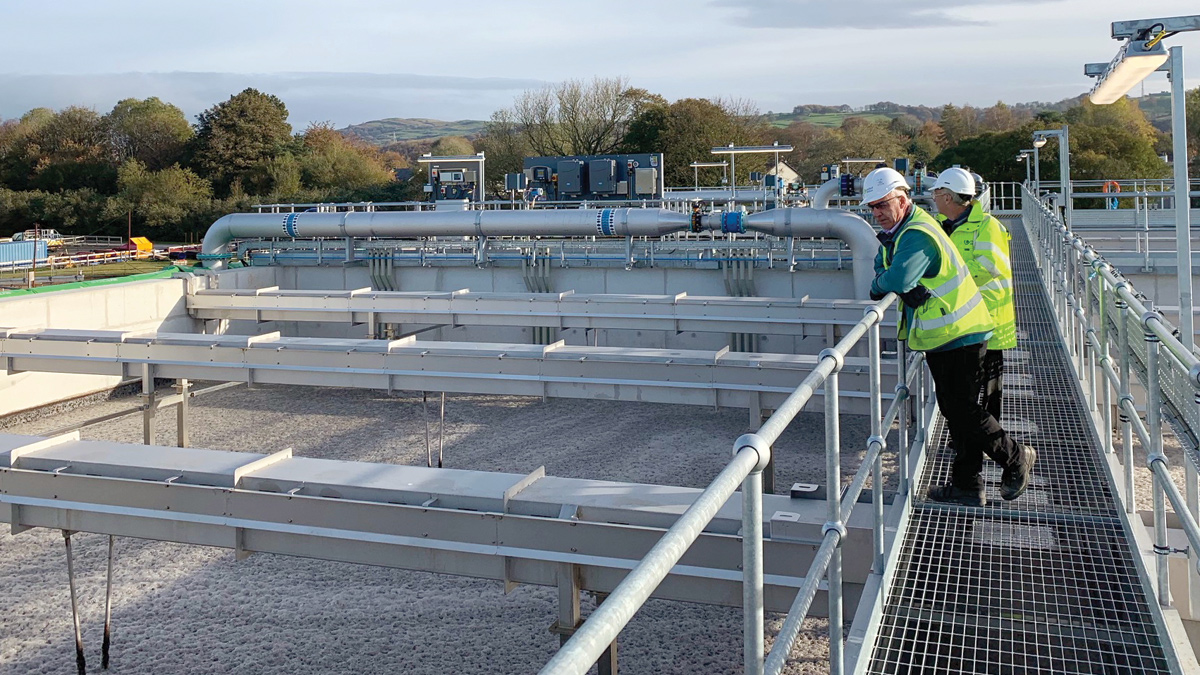
On top of Nereda® tank – Courtesy of United Utilities
Progress to date
To kick start the biological process, sixty tanker loads of seeded sludge were brought in from several site locations. The first flows to Nereda® were turned in October 2018, following several months of intense testing and commissioning.
United Utilities and LiMA worked collaboratively together to produce staged commissioning plans, achieving several (ATO) Agreement to Operate points. Ensuring that the seeding of the biological process, whilst integrating with live assets was a success.
Joint weekly commissioning meetings were held with both internal Asset Supportability staff and the Operations team from United Utilities. Ensuring that daily goals and weekly objectives forming the commissioning schedule were met, achieving the staged integration with existing assets.
There was a complex phased transition from the old process to the new Nereda® process, with the regulatory date of 20 March 2019 being successfully achieved. Performance testing commenced June 2019, and the new treatment process is currently going through a further optimisation period. United Utilities recognise the successful collaboration throughout the project, which has resulted in Kendal WwTW is now treating effluent to higher standards than ever before.









